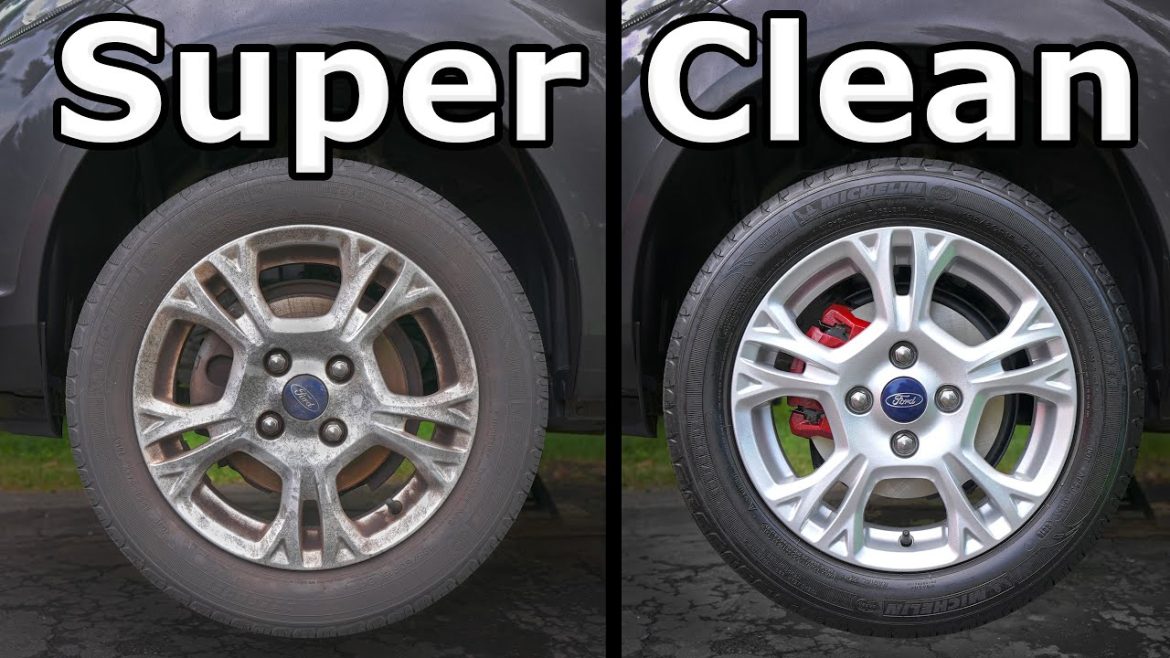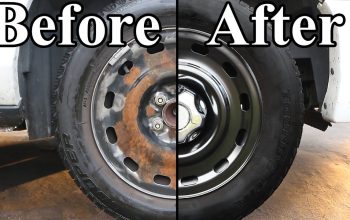ChrisFix demonstrates an effective, detailed method to super clean vehicle wheels and tires, focusing on removing years of built-up brake dust, stains, and tar to restore them to a near-new appearance. The process is designed for any vehicle type, from daily drivers to high-end or race cars, and involves five fundamental steps: rinsing, cleaning, drying, stain removal, and protection. ChrisFix emphasizes the importance of using the right tools and products—including a safe wheel cleaner with iron decontamination properties, brushes for agitation, clay bars, compounds, and ceramic coatings—to achieve professional-level results. He also covers the often-overlooked areas such as lug nut wells, wheel barrels, valve stems, and tire sidewalls, explaining how to clean and protect these surfaces effectively. The tutorial concludes with tips on maintaining clean wheels and tires, protecting the wheel wells and suspension components, and ensuring that the wheels’ appearance remains pristine longer with routine care.
### Highlights
– 🧼 Five-step process to super clean wheels and tires: rinse, clean, dry, stain removal, and protection.
– 🛠️ Use of specialized tools such as plastic-coated lug nut sockets, various brushes, clay bar, and rotary tool for stain removal.
– 💜 Iron decontaminating wheel cleaner that changes color as it dissolves brake dust particles.
– 🔥 Innovative use of a heat gun to soften stubborn tar spots for easier removal.
– 🛞 Detailed tire cleaning and dressing to prevent dry rot, including explanation of anti-ozonate blooming.
– 🛡️ Application of ceramic detailing spray for wheels and tire gel with UV protection for tires.
– ⚠️ Safety tips, including avoiding tire dressings on race cars or motorcycles and ensuring no dressing contacts brake components.
### Key Insights
– 🧽 **Importance of a Thorough Cleaning Routine:** The tutorial’s five-step process underscores that proper wheel care is not just about surface dirt but involves deep cleaning, stain removal, and protection. This comprehensive approach is necessary to prevent permanent damage caused by brake dust and tar, which can corrode and stain wheel surfaces if left untreated over long periods. ChrisFix’s example of two years’ worth of brake dust accumulation exemplifies the severity of neglect and the value of regular maintenance.
– 🔬 **Role of Iron Decontamination in Wheel Cleaning:** Brake dust contains iron particles that embed in the wheel’s paint and finish, leading to corrosion. The iron decontaminating wheel cleaner, which turns purple as it interacts with iron particles, is essential to chemically break down these embedded contaminants. This process prevents the brake dust from permanently etching into the wheel and allows physical agitation through brushes to remove loosened grime effectively.
– 🖌️ **Use of Specialized Tools Enhances Cleaning Efficiency:** Brushes with plastic bases and wooden handles provide gentle yet effective agitation, especially in tight spots like lug nut wells and valve stems. The use of plastic-coated lug nut sockets protects wheels from accidental scratches during removal. Furthermore, power tools like rotary buffers dramatically improve the stain removal process in heavily soiled areas, such as lug nut wells, saving time and effort while yielding professional results.
– 🔥 **Heat Gun as a Tar Removal Aid:** Tar is a particularly stubborn contaminant that can be difficult to remove with typical cleaners. ChrisFix’s innovative use of a heat gun to soften tar spots before applying tar remover demonstrates an effective technique that enhances cleaning efficacy without damaging the wheel’s paint. This approach highlights the value of leveraging simple tools creatively to tackle challenging cleaning tasks.
– 🛞 **Tire Cleaning and Protection Are Critical Yet Often Overlooked:** Tires naturally develop a brown tint due to anti-ozonate agents blooming to protect rubber from UV damage and dry rot. Cleaning tires removes this protective layer, so applying a suitable tire gel with UV and ozone protection is crucial to maintain tire longevity. ChrisFix’s detailed method using soft and stiff brushes ensures deep cleaning of textured tire sidewalls, allowing the dressing to bond properly and reduce sling during driving.
– 🛡️ **Ceramic Detailing Spray Enhances Longevity and Ease of Maintenance:** Applying a ceramic coating to wheels not only adds gloss and depth to the paint finish but also creates a protective barrier that prevents brake dust from embedding deeply. While it doesn’t stop brake dust accumulation, it makes future cleaning easier and less damaging. This step is an important investment in preserving the wheels’ appearance and reducing long-term maintenance effort.
– ⚠️ **Safety Considerations for Tire Dressings:** The video’s warning against using tire dressings on race cars or motorcycles is a crucial insight often overlooked by enthusiasts. Since the tire sidewalls contribute to grip during extreme cornering, applying slippery dressings could compromise traction and safety. Additionally, avoiding tire dressing on brake components prevents hazardous conditions like brake failure or slipperiness, emphasizing the importance of careful application.
### Detailed Overview
ChrisFix begins by explaining the rationale behind his super clean wheel tutorial, choosing a vehicle with wheels neglected for over two years to demonstrate the effectiveness of his process. His goal is to show that even heavily soiled wheels can be restored with patience and the right technique. The tutorial applies universally across vehicle types.
The cleaning process starts with rinsing the wheels to remove loose dirt and brake dust. While a pressure washer is ideal, he shows that a garden hose with high pressure can suffice. Next, he advocates using a wheel cleaner with iron decontamination properties, which chemically reacts with embedded iron particles, turning purple as the brake dust dissolves. Brushes of different sizes and stiffness are used to agitate the cleaner, reaching difficult areas such as valve stems, lug nut wells, and the rim gaps.
Removing the wheels allows better access for deep cleaning, particularly inside the barrel and behind the spokes, where brake dust accumulates and causes corrosion. ChrisFix demonstrates safe wheel removal techniques using jack stands and recommends plastic-coated lug nut sockets to prevent accidental paint damage.
After the initial cleaning, drying with microfiber towels prevents water spots, which can stain the wheels. For stubborn stains, ChrisFix uses a clay bar to pull out embedded contaminants gently. He stresses the importance of lubricating the surface with a cleaner to avoid scratching the paint. For more severe staining, such as in lug nut wells, he employs a rotary tool with wool buffing wheels combined with a compound to restore the surface efficiently.
Tar removal is addressed with a specialized bug and tar remover and a stiff brush, with the additional tip of softening the tar using a heat gun to improve removal ease without harming the paint.
Tire cleaning is treated as an essential part of the process. ChrisFix explains the phenomenon of anti-ozonate blooming, which causes a brown tint on tires, and stresses the need to replace the protective layer removed during cleaning. He demonstrates a two-step brush cleaning using soapy water and a stiffer brush to ensure deep cleaning of textured sidewalls before applying tire gel. The gel provides UV and ozone protection and can be buffed to achieve a desired finish from matte to wet gloss.
The final protective step involves cleaning the wheels with alcohol to remove residues and applying a ceramic detailing spray, which bonds to the clean surface to prevent brake dust from embedding and makes future cleaning easier. The tire dressing is applied carefully using a microfiber towel and brush to ensure even coverage and avoid overspray onto brake components.
ChrisFix also briefly covers cleaning and protecting the wheel wells and suspension parts. He rejuvenates plastic liners with ceramic trim restore products and improves the appearance of suspension and brake calipers with paint, emphasizing the importance of complete attention to detail for a professional finish.
He concludes with maintenance advice to avoid frequent full super cleans by regularly rinsing, lightly cleaning, and protecting wheels, ensuring they stay in great condition with minimal effort.
### Conclusion
ChrisFix’s tutorial provides a thorough, professional-grade guide for anyone looking to restore and maintain their wheels and tires. His methodical approach, combined with practical tools and safety tips, ensures that even wheels with years of neglected brake dust and stains can be transformed dramatically. The emphasis on protection and maintenance ensures longevity of results and enhances the vehicle’s overall aesthetic and resale value. This video is a valuable resource for car enthusiasts and everyday drivers alike, showcasing that with the right knowledge and products, wheels can be kept looking brand new.


